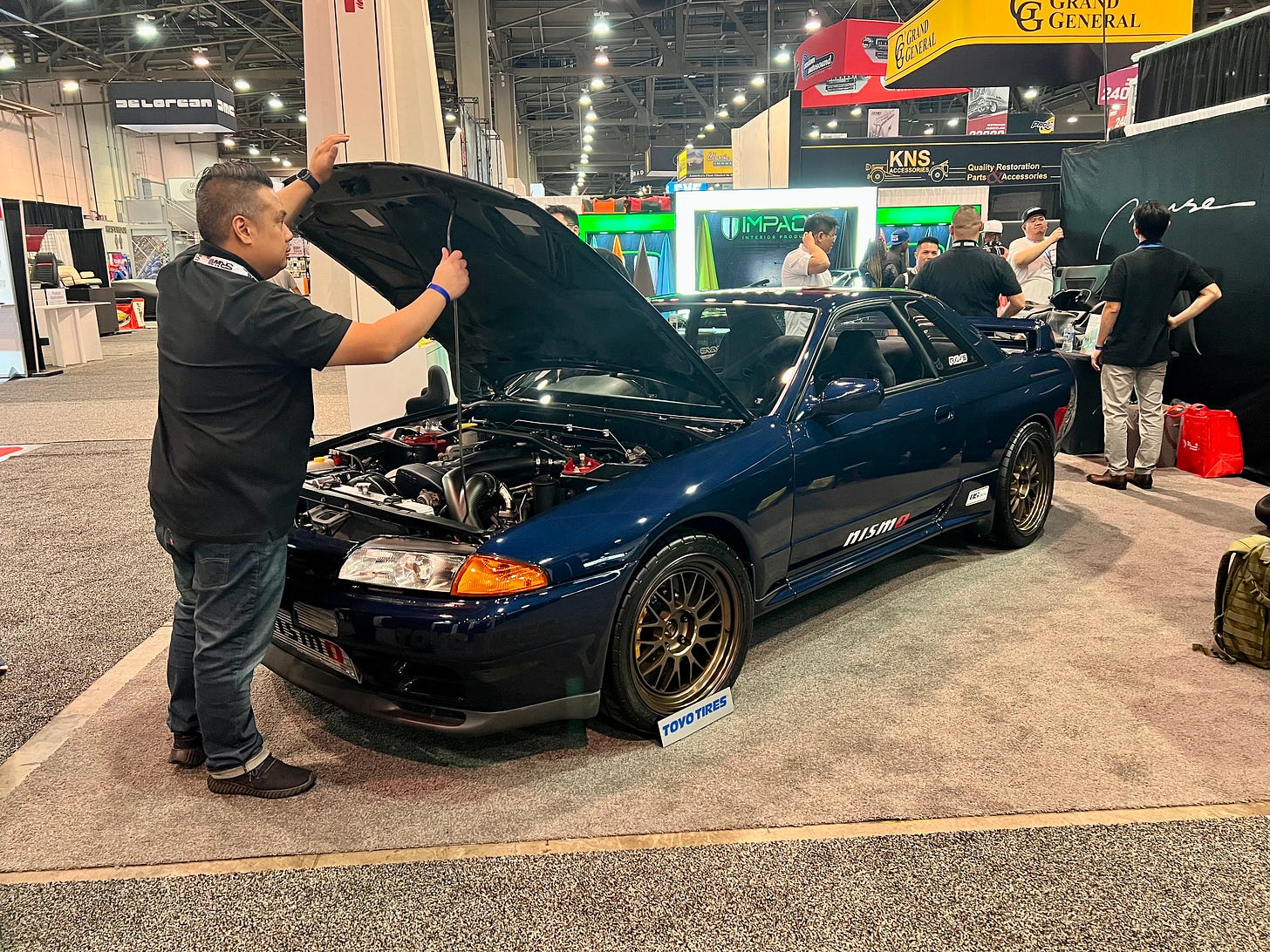All the Tea from SEMA 2023
As the aftermarket grows, smaller companies feel the pinch. Here's what I found.
HAPPY RACE DAY, especially to the genius who built this at SEMA 2023 here in Las Vegas.
Japanese market Honda Acty race truck! Adorbs. I am all the way here for it.
Yes, I’m in Vegas. I’m taking a break from virtually promoting my latest release, Cult of GT-R. Instead, I am physically promoting it.
Today and tomorrow I’ll be displaying Cult of GT-R at the SW Lights booth at SEMA from 2:00-4:00pm. Follow here for more. Come on by and say hello!
You can preorder the book right here.
SEMA 2023 is No Joke
SEMA, or the Speciality Equipment Manufacturers Association, is a big deal.
Its annual show in Las Vegas is the biggest showcase for the aftermarket industry. The most recent SEMA report estimates that Americans spend $52 billion upgrading their vehicles each year.
Still, a lot of people don’t take it seriously. SEMA is tainted by the 2000s era of the aftermarket. During that time, The Fast & the Furious was hot. Underbody glow and “lift-up” scissor doors were all the rage.
But the industry has grown up since then.
Now, the aftermarket is dominated by big brands. Whether its Mothers car care products, Magnaflow exhaust systems or BF Goodrich tires, this is the sweet spot for a lot of companies. People want to buy cars and make them better.
Automakers themselves are getting into the game. I’m here by invitation of Toyota and Lexus. Together, they’ve taken over a massive space once dominated by Ford. They’re showing aftermarket creations intended for models new and old alike.
On the night I arrived, Lexus and Toyota gave us a sneak peek of their creations for the show. Among others, they included new accessories for the Lexus GX, Lexus LX, Toyota Tundra and Toyota GR Supra.
Toyota and Lexus are partnering with aftermarket companies to help buyers purchase accessories on the spot at dealerships, and roll it into their monthly payments. They’re also producing some of those accessories in-house.
If you can roll your own products into monthly payments, that’s even better.
This has likely built the aftermarket into a $52B juggernaut. Automakers are looking for ways to optimize consumer desire for accessories, and include it into their loan terms. For a lot of customers, it’s an easy decision.
But what I heard on the show floor at SEMA is that traditional aftermarket brands are struggling to keep pace.
While automakers have rolled accessories into the purchase price of a vehicle, many aftermarket companies are begging customers to add in purchases after the fact.
These companies are more susceptible to economic trends.
Some said that recent downturns have made buyers reluctant to spend. Others said that they’ve seen gradual growth. Still others said that early post-Covid conditions gave people low-interest money to spend that has since dried up.
Compared to a Toyota or Lexus, a company specializing in seats or wheels or speakers may struggle to attract attention when interest rates are high. Money is tight.
Skylines and JDM at SEMA 2023
Still, it appears demand has never been higher.
Enthusiasts can and will spend money in the aftermarket. The question is: How do you reach them?
On the first day of SEMA 2023, I spoke to several brands dealing with that issue. Obviously, if you have strong name recognition, it isn’t much of a problem.

But a lot of U.S. customers are looking abroad for solutions. And those foreign companies sometimes struggle to reach our market.
Some JDM (Japanese domestic market) companies I spoke with said that:
U.S. customers want high quality, but they also want it cheap.
U.S. customers want high quality, but they also want it fast.
The old axiom is that you can pick two of the three: good; cheap; or fast.
You don’t get all three.
In my world, Americans are looking to Japan specifically to deliver these products. It’s based on the history, prestige and credibility they can provide. But Japanese companies simply don’t work on the same timeline as U.S. consumers.
I spent Tuesday chatting with Muse, which upgrades all aspects of the Skyline GT-R. Demand is high. But the company is struggling to adapt to Americans who want things now — at a low price, and high quality.
For companies that pride themselves on craftsmanship, it simply doesn’t work.
You know who it does work for? Big manufacturers.
The most telling thing for me during the Toyota-Lexus preview was that both companies now make in-house accesories for off-road capability. The products can be installed when you purchase the vehicle. And they’ll install on site.
The convenience factor is off the charts. Seems like a win for buyers, right? But you have to realize all the ways Toyota-Lexus make off with the bag in this scenario.
The company sells you the car. They also sell you their own accessories. They also roll it into monthly payments, with interest, in a financing branch that they own. It’s a triple-edged sword that only cuts in one direction.
All of this is fine. And perfectly legal.
But is it affecting that $52 billion number? Because OEMs are getting more savvy. And I’m finding that more specialty companies are fighting each other. Haplessly.
It seems like a conversation worth having. Aftermarket comapanies are where much of the innovation comes from. We wouldn’t have autocross or overlanding without them.
But if big automakers adopt and swallow their practices, are we winning? Or is this encroachment that hampers accessory companies?
I guess we’ll see in SEMA 2024.
Drive hard and be safe. Black Lives Matter.
Race Day has subscribers in 33 states and 17 countries! Want your event included? Shoot me a note with subject line “Race Day” at ryan@carrarabooks.com.
Check out Carrara Media on Instagram, Twitter and Facebook and visit our store to order one of our many fine books and eBooks.








